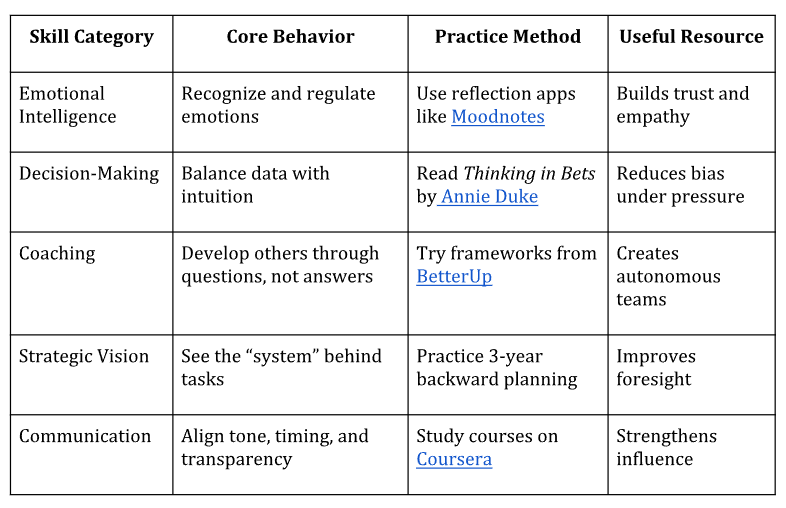
Image via Pexels
By Julie Morris
Leadership isn’t a title—it’s a transferable skill set that compounds over time. Whether you’re managing a small startup, leading a remote team, or mentoring a creative collective, effective leadership depends on how consistently you communicate, motivate, and evolve.
Major Takeaways
Strong leaders communicate with clarity, act with empathy, and learn faster than their challenges evolve. To strengthen your leadership:
● Develop consistent feedback loops (1:1 and team-wide).
● Practice self-awareness and reflective listening.
● Build decision systems that reward collaboration, not control.
● Continuously expand your perspective through learning and mentorship.
The Foundation: Leadership as a Learnable System
Great leaders aren’t born—they’re iterated. Leadership is a living system built from behavior, reflection, and structure. The most resilient leaders:
● Define values early. Clarity prevents misalignment when pressure rises.
● Build self-awareness routines. Journaling or peer check-ins reveal blind spots.
● Balance confidence with humility. Admit what you don’t know; it invites stronger teams.
If leadership feels intangible, start small. Build one trust ritual (like weekly recognition rounds) and one improvement habit (such as monthly skill reviews). Over time, these become your leadership infrastructure.
The Communication Core
No leadership skill compounds faster than effective communication. Transparent dialogue creates alignment, motivation, and psychological safety. A key principle is keeping communication loops open—especially through individualized conversations.
That’s why focusing on improving communication skills is central to leadership development. Strong leaders foster clarity in every direction: upward, downward, and laterally.
● Use one-on-one conversations to understand personal motivators and barriers.
● Share context before feedback—employees interpret direction more constructively when they understand why.
● Use shared digital channels like Slack or Basecamp for asynchronous transparency.
Effective communication doesn’t just transmit information—it reinforces trust, sets tone, and keeps momentum visible.
Leadership Skill Matrix: Where to Focus Growth
 *Moodnotes
*Moodnotes
Annie Duke
BetterUp
Coursera
The Leadership Upgrade Checklist
Clarity of Purpose
● Write your top three leadership values.
● Define how each value shows up in action.
Empathy and Presence
● Block 15 minutes daily for undistracted listening.
● Ask your team what support they actually need, not what you assume.
Continuous Learning
● Set quarterly learning goals (one behavioral, one technical).
● Follow leadership thinkers on LinkedIn Learning for adaptive insights.
Delegation and Empowerment
● Identify 3 tasks to delegate this week.
● Document your process instead of micromanaging outcomes.
How-To: Strengthen Leadership Skills in 5 Practical Steps
Step 1: Audit Your Leadership Baseline
Ask your team (or peers) for one piece of feedback on your clarity, consistency, and emotional presence. Aggregate patterns—not isolated opinions.
Step 2: Design a Communication Ritual
Hold weekly 15-minute check-ins to align expectations and listen. Document insights in tools like Notion.
Step 3: Train Your Decision Muscles
Use post-mortems after major decisions. Record assumptions → actions → results → lessons learned.
Step 4: Grow Through Reflection
After every challenging interaction, write what you noticed, how you felt, and what you could improve next time. Reflection converts mistakes into mastery.
Step 5: Connect Beyond Your Role
Join leadership cohorts or communities on Meetup or Harvard Business Review’s resources for continuous exposure to new thinking.
Common Leadership Questions (FAQ)
Q1: What’s the first leadership skill to develop?
Active listening. It creates credibility faster than directives.
Q2: How do I stay confident under pressure?
Use breathing or grounding routines—try the 4-7-8 technique—to regulate responses before reacting.
Q3: Can introverts be effective leaders?
Absolutely. Introverts often excel in reflection, empathy, and structured communication.
Q4: How do I build trust remotely?
Combine transparency with predictability. Use consistent meeting rhythms and shared documentation.
Q5: How do I measure leadership growth?
Look for qualitative signals: improved retention, increased collaboration, and honest feedback flow.
Product Spotlight: Apple AirPods Pro (2nd Gen) — The Leader’s Quiet Companion
In a world full of notifications and virtual noise, focus is now a leadership superpower. The Apple AirPods Pro (2nd Gen) delivers active noise cancellation and transparency modes that help leaders transition seamlessly between focus and feedback.
Their spatial audio enhances virtual meetings, while adaptive EQ maintains clear tone—ideal for maintaining attention during long calls or deep work blocks. Great leaders don’t just listen; they hear with precision.
Glossary
Feedback Loop: The recurring exchange of performance insights between leader and team.
Emotional Intelligence (EQ): Awareness and management of one’s own emotions and those of others.
Active Listening: Paying full attention, confirming understanding, and responding thoughtfully.
Growth Mindset: The belief that abilities can be developed through effort and feedback.
Systemic Thinking: Understanding how individual actions interact within larger organizational systems.
Leadership mastery is a process of alignment—between intent and action, communication and empathy, growth and guidance. By grounding your leadership in clarity, consistent communication, and continuous learning, you build credibility that scales with your
organization. In the end, great leadership isn’t about control—it’s about connection.
Discover strategic insights and expert guidance to elevate your communication efforts by visiting Managing Communications today!
